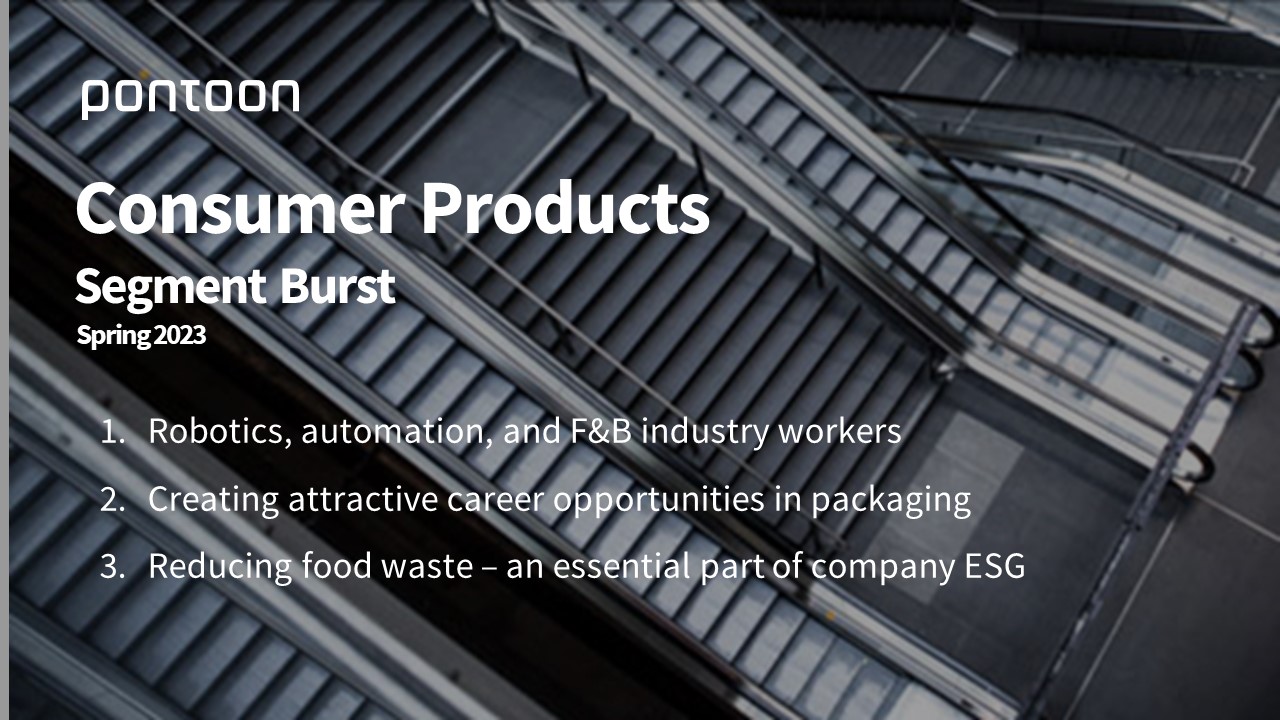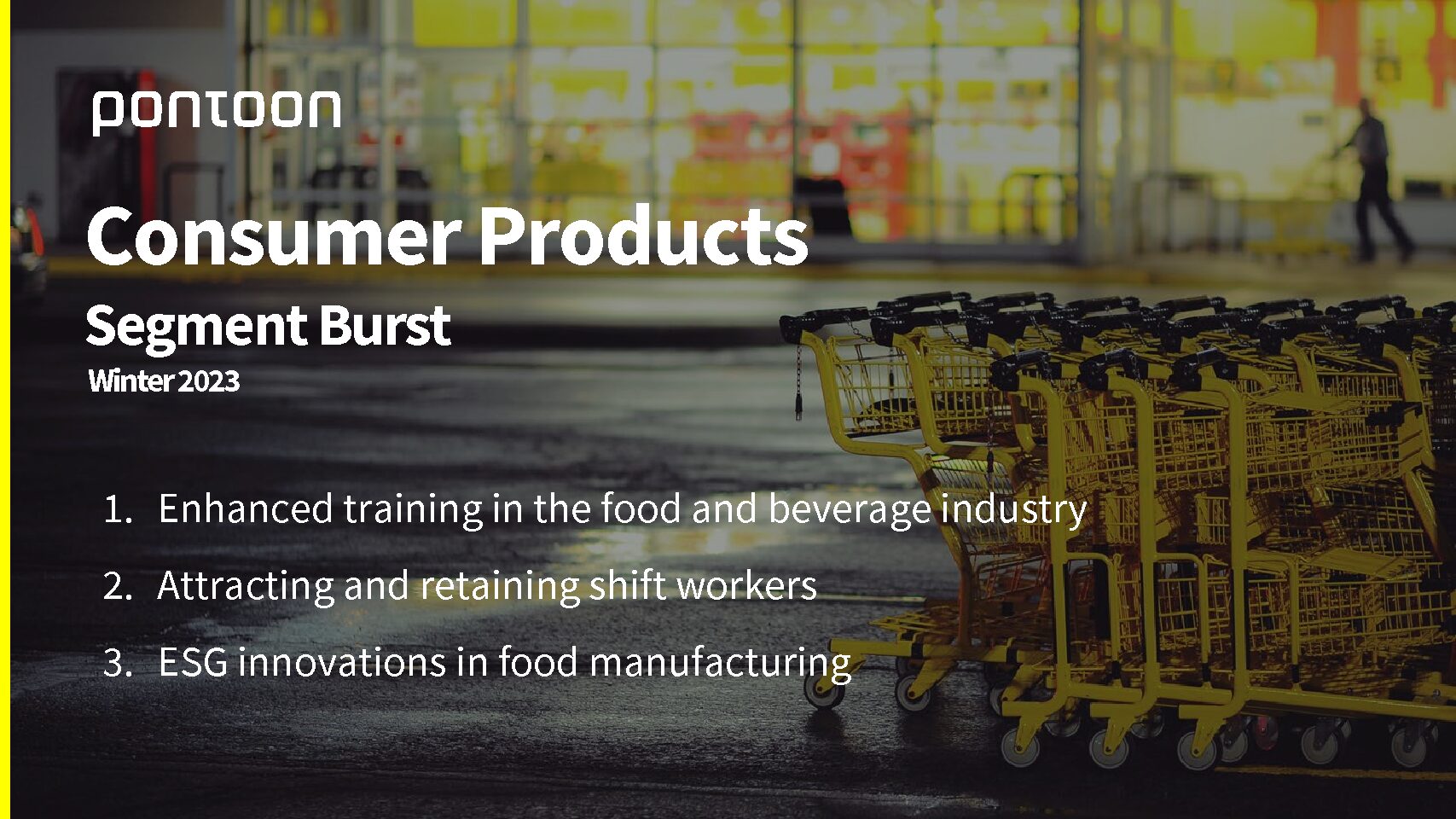Consumer Products Segment Burst: Spring 2023
Research
.
In the new volume of Consumer Products Segment Burst, we explore the most recent trends in the sector, including:
-
Impact of robotics and automation on workers in the food & beverage industry
-
Creating attractive career opportunities in packaging
-
Food waste reduction as an essential part of company ESG
Read on to find out.
Robotics, automation, and F&B industry workers
The global food robotics market is expected to reach $4 billion by 2028. Production is expanding due to a higher demand for food products. In order to meet this demand, the industry is improving its efficiency.
While robotics in the food and beverage industry have raised concerns about making the traditional workforce obsolete, automation can benefit businesses and employees.
Robots can reduce the risk of accidents in food factories by taking over dangerous or physically demanding tasks – such as lifting heavy items, working in high-temperature environments, or handling sharp objects.
Moreover, robots can ease the effects of labour shortages in the food industry by performing repetitive or monotonous tasks (e.g. packaging, palletising, and processing). This can help companies maintain production levels and meet demand even when there is a shortage of available talent.
Automating specific tasks does not mean that robots will replace human labour entirely. Instead, robots can free up workers’ time, allowing them to focus on more complex or skilled tasks. Thanks to automation, workers in the F&B industry can upgrade their careers, and companies can ensure better retention rates through upskilling.
F&B companies should communicate and engage with workers in adopting automation to mitigate any negative impact on morale and turnover. Importantly, automation also calls for legal, cybersecurity, and data privacy talent since using advanced technologies has legal ramifications that F&B companies need to consider.
Creating attractive career opportunities in packaging
According to Deloitte, 58% of surveyed workers in the US are convinced that manufacturing jobs offer limited career opportunities. Jobs in the packaging segment, in particular, are not viewed as attractive career paths – the traditional perception is that they are based on repetitive manual labour.
To change that, consumer products companies should highlight the diversity of roles and skills needed in packaging. Some jobs require creativity, critical thinking, management, knowledge of new technologies, or even scientific degrees. For instance, jobs in packaging innovations and packaging science offer exciting challenges related to improving design processes (including recyclability) and limiting the usage of materials, waste, and energy.
Reframing consumer product packaging as a site of innovation, research, and sustainability – and incorporating those values into the EVP – can help companies to attract highly skilled talent.
Of course, managerial, scientific, and design packaging functions entail a substantial amount of skills, experience, and education. So what about those roles in packaging that are, indeed, based on manual labour?
Deloitte’s research shows that a whopping majority of workers (80%) would be interested in manufacturing if enhanced training and clear career paths were offered.
To make packaging operator and packer jobs more attractive to prospective candidates, CP companies should confirm that each job ad has a clear career pathway and a tentative timeline for potential career advancement steps.
When workers know their career progression options, they might be more willing to apply for packaging roles and stay with the company longer. With the company’s support and clear expectations about skills and experience required for internal mobility, employees in packaging can approach jobs more strategically, i.e. as a career that helps them to grow and receive higher compensation.
Importantly, once on the job, employees should also be free to explore lateral career moves to find valuable learning opportunities, better work-life balance, or a team leader that helps them realise their full potential.
Reducing food waste – an essential part of company ESG
With up to one-third of global food wasted, producers must take accountability and reduce food waste in the supply chain. The stakes are high since food waste accounts for 8-10% of global greenhouse gas emissions.
Apart from countering negative environmental impact (necessary to ensure our collective survival as a species), companies can leverage food waste reduction to enhance their brand image and attract both consumers and talent.
According to PwC, 86% of employees prefer companies that care for the same social and environmental issues that they do. 76% of consumers declare they would not buy a product from a company that harms employees, communities, and the environment.
By reducing food waste, companies demonstrate their commitment to ESG. By creating more sustainable supply chains and ensuring food does not end up in landfills, businesses can support local communities and improve public health, thus becoming ESG leaders.
Since the most effective strategies for reducing food waste require new technologies, food producers should seek to expand the pool of tech talent capable of driving meaningful change in that area.
As in any other type of manufacturing, the key to attracting tech talent is framing the food industry as a site of digital innovation, offering competitive compensation, and empowering employees to reskill.
Strategies for reducing food waste in the supply chain
- AI-powered tools help companies optimise inventory management by predicting demand, identifying inefficiencies, and reducing overstock. Deploying these tools can prevent food waste caused by excess inventory or expired products.
- Blockchain technology can ensure supply chain transparency by tracking the movement of food products across the entire chain (“from farm to fork”). Blockchain enables storing and sharing data and transactions in a secure database that users can share in real-time. Insights generated by blockchain can be used to identify inefficiencies in distributing and handling food products.
- Predictive analytics help food manufacturers forecast demand, plan production, and manage inventory. Analysing historical data and trends allows companies to make more informed decisions about their supply chain and eliminate overproduction.
Related Post
In the new volume of Consumer Products Segment Burst we explore the most recent trends in the food manufacturing industry.
How enhanced training opportunities can improve talent attraction in the ...





